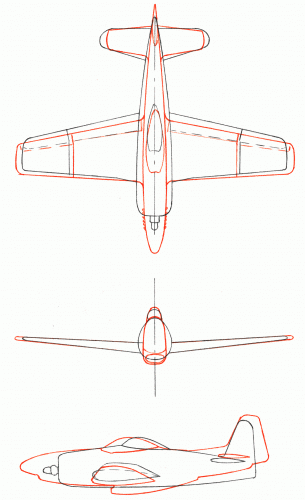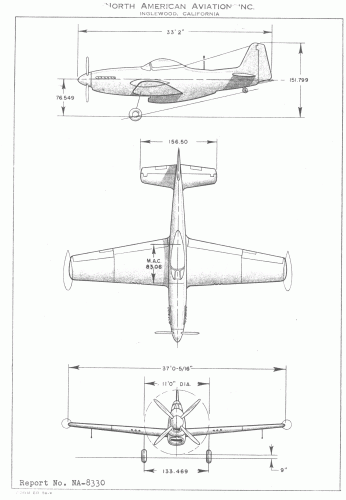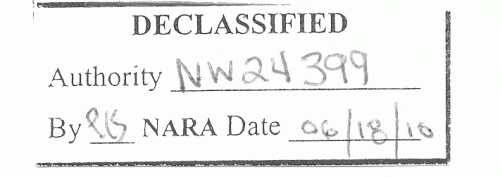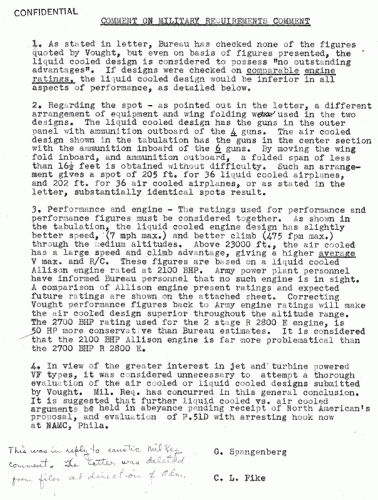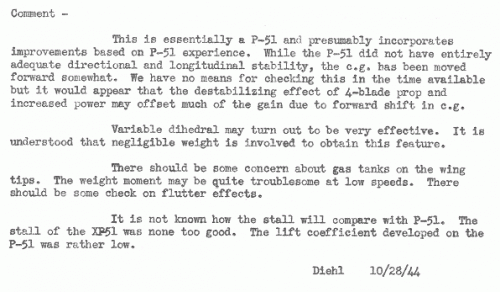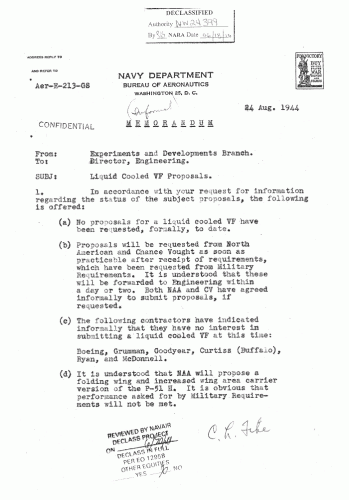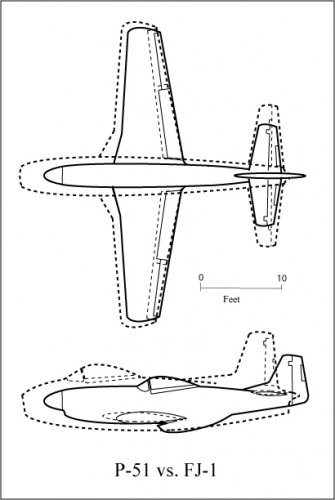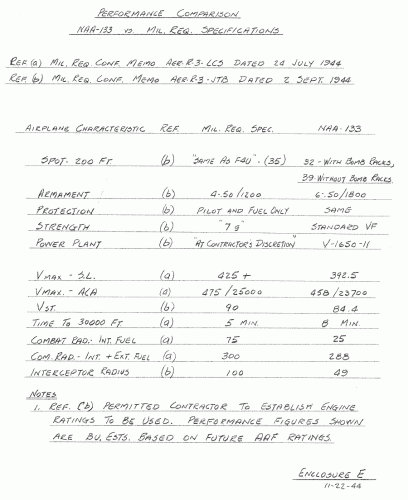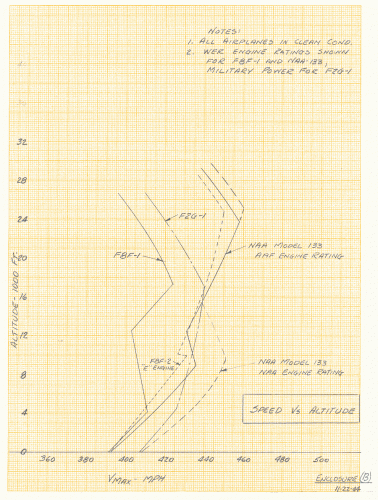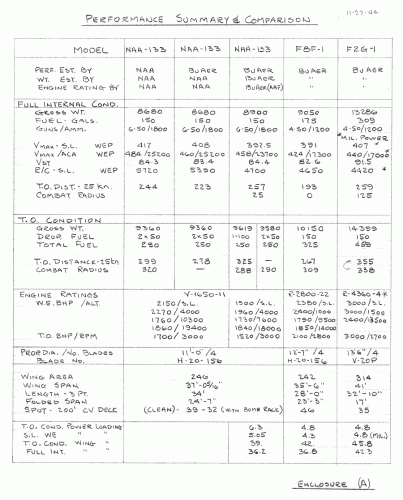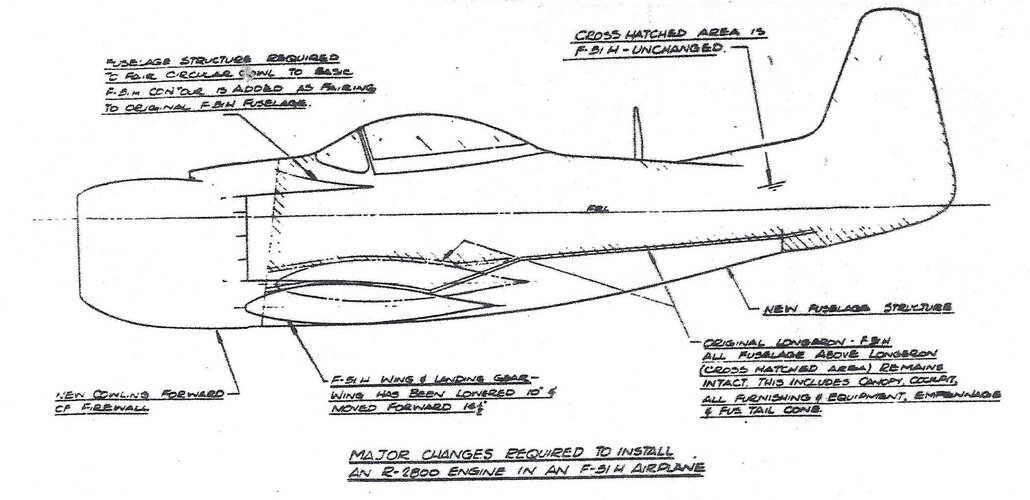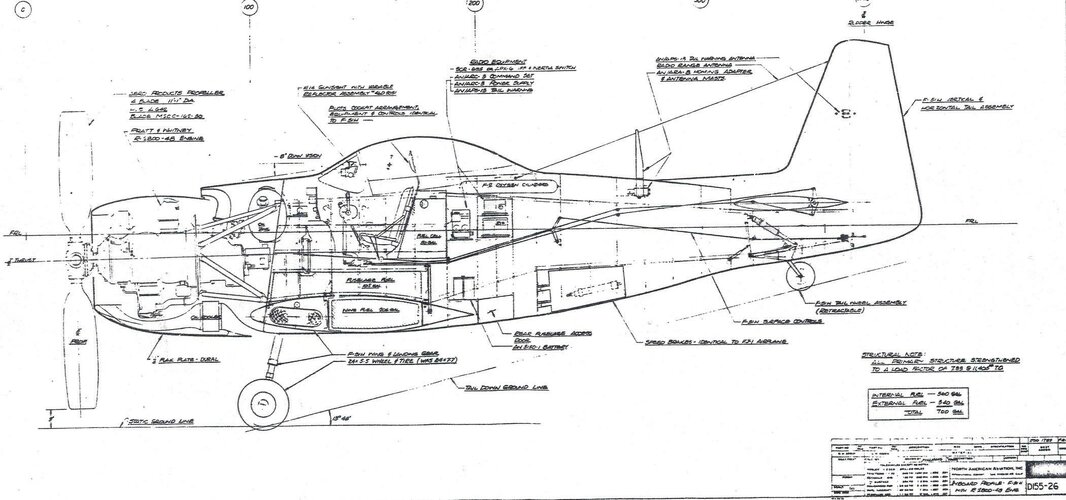Aer-E-213-CS
MEMORANDUM
11/25/44
SUBJ: Model VF Airplane - North American Aviation Model 133, Liquid Cooled Proposal -Summary of.
Refs:
(a) NAA Conf. Ltr. AL-874, dated 20 Oct. 1944•
(b) NAA Conf. Ltr. AL-889, dated 3 Nov. 1944-
(c) DCNO (Air) Conf. Memo. OP31-C1-MML, (SC) A21-1, Serial 053031, dated 21 March 1944.
(d) Mil. Req. Conf. Memo. Aer-R-3-LCS, dated 24 July 1944.
(e) Engr. Conf. Memo. Aer-E-211-GS, VF, dated 21 Aug. 1944.
(f) Mil. Req. Conf. Memo. Aer-R-3-JTB, dated 2 Sept. 1944.
Encls : (HW)
(A) Performance Summary and Comparison, dated 11—22 —44.
(B) VF Speed vs. altitude Comparison, dated 11 —2 2 —44.
(C) VF Climb vs. Altitude Comparison, dated
(D) VF Combat Radius vs. T.O. Dist. Comparison dated 11-24-4-4.
(E) Comparison, NA-133 vs. Mil. Req. Specification, dated 11-22-44.
(F) V-1650-11 Engine Rating Curve Sheet, dated 11-13-44.
1. By refs. (a) and (b), North American Aviation, Inc. has submitted engineering, cost and delivery data on a carrier basedVF airplane powered with a V-1650-11 liquid cooled engine, as Informally requested by the Bureau.
2. The history of this proposal dates back to ref. (c), which requested a review of the aviation experimental program to determine whether carrier based aircraft should be utilizing liquid cooled engines to obtain high performance in smaller' sizes of airplanes. Comments on ref. (c) indicated a wide diversity of opinion on the question, and ultimately resulted in ref. (d) requesting that proposals from various contractors be obtained for a carrier based VF airplane powered with a liquid cooled engine. Ref. (f) provided a clarification of requirements as requested by ref. (e). A number of contractors were requested informally to submit such designs, but North American Aviation was the only company willing to submit a complete proposal. Chance Vought made some preliminary studies in a comprehensive fighter design survey, but reached the conclusion that other types of power plants were more suitable for future fighters. The remaining contractors were unwilling to attempt liquid cooled designs at this time.
3. The North American Model 133 is similar to the P-51H Airplane being procured by the Army. The power plant is a fuel injection, Packard built, Merlin V-1650-11 engine equipped for water injection, and the installation is substantially identical to that of the P-51H. The wing has been redesigned for folding, 10 sq. ft. of area added, slotted flaps incorporated instead of split flaps, and larger ailerons with power boost have been installed. The landing gear has been modified to meet Navy strength requirements. The fuselage fuel tank of the P-51H has been eliminated, and the wing fuel cells capacity reduced to give a total of 150 gal. of protected fuel. Elimination of the fuselage fuel tank reduces the e.g. travel, permitting use of a smaller horizontal tail, while maintaining adequate longitudinal stability. Arresting and catapult provisions are basically similar to those installed on a P-51D, though somewhat improved from a drag standpoint.
4. The interested branches of the Engineering and Maintenance Divisions have examined the data available, and a number of details found which require correction if the design Is to be procured. The discrepancies are not major, and do not affect the performance of the airplane to a sufficient extent to require submission of a revised proposal. Wing tip drop tanks of 50 gal. capacity have been proposed, primarily to better the airplanes spotting characteristics by allowing the tail to pass under the center section of the wing. The nonstandard tanks seriously complicate the fuel system, introduce handling and filling complexities as well as aggravating the logistics problem. Since the spotting advantage of 39 airplanes as compared to 32 airplanes in a 200 ft. deck length exists only when bomb racks and rocket launchers are not installed, it is considered that a standard 100 gal. tank suspended from the wing bomb rack is a superior installation.
5. Performance characteristics of any airplane are proportional to the engine ratings available. In ref. (e), Engineering requested certain data to permit establishment of naval ratings for liquid cooled engines. Military Requirements, in ref. (f), indicated that power plant reliability and fuel type were to be at the contractor's discretion. North American's performance was submitted on 90 inch manifold pressure ratings, using 150 grade fuel and water injection. These ratings are not in agreement with Army, British or Packard data. Two Bureau performance estimates were made, one to check the NAA figures, and the other at the weights estimated by the Bureau, slightly higher than those of NAA, and at the engine ratings given by the Army as their anticipated future ratings. These ratings are shown on End. (F), with the V-1650-3 present rating indicated for comparative purposes only. It will be noted that the normal rating of the engine is less than the R-1820 or R-1830 at sea level, while the W.E.P. rating used by North American approaches that of the R-2800.
6. A summary of performance characteristics for the design Is shown on Encl. (A), while speed,, and climb curves comparing the airplane with the F8F-1, F8F-2 ("E" Engine) and F2G-1 are included as Encls. (B) and (C). The F8F performance shown is the Bureau estimate of the production airplanes with both the present "C" engine and the future "E" engine, while the F2G-1 is shown at the current military rating. Previous comparisons using the "E" engine have been subjected to criticism as a hypothetical engine. The V-1650-11 engine is not scheduled for production until June 1945, and the NAA-133 airplane is not promised until 9 months after date of contract, it therefore appears proper to use the "E" engine in the comparison since current estimates are that it will start in production by 1 Sept. 1945. An experimental F8F-2 should be flying during the spring of 1945. A plot showing combat radius (standard VF problem) spotted against take-off distance is included as Encl. (D).
7. Encl. (E) shows a comparison of the characteristics of the NAA-133 airplane with those specified by Mil-Req. It is obvious that the design fails to meet the desired performance by a wide margin.
8. The most serious disadvantages of the NAA-133 design for carrier use that have been mentioned are:
(a) Increased vulnerability inherent in any liquid cooled arrangement over air cooled types.
(b) Increased maintenance because of addition of radiators and aftercoolers.
(c) The airplane as presented will possess the poor ditching characteristics of the P-51 series airplanes.
(d) Introduction of liquid cooled type will increase logistic problems, and necessitate an additional training program.
9. This memorandum has been prepared to summarize the NAA-133 proposal data for use in the conference now scheduled for 1400, Monday, Nov. 27, 1944.
W. Z. FRISBIE

